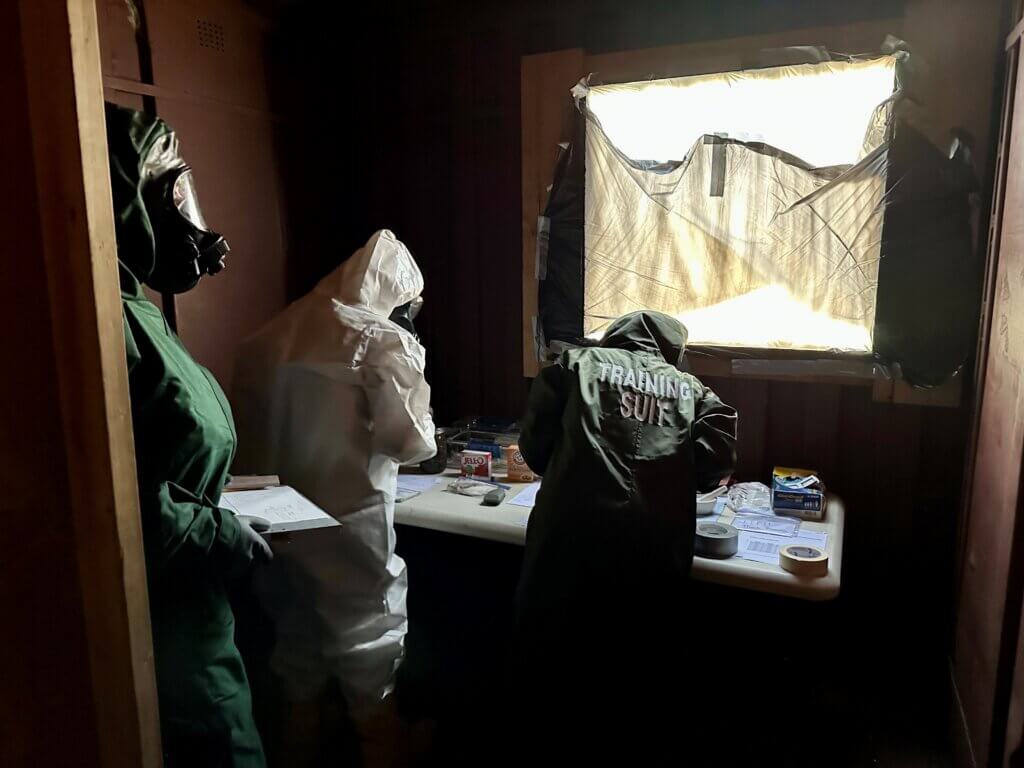Western Alaska is “really at the forefront of the gateway to the west,” making it an ideal location for biennial training that prepares guardsmen, local and national agencies and first responders in the event of an attack.
“You have the arctic becoming far more accessible in terms of sea traffic,” said Alan Brown, director of communications and public affairs for the Alaska National Guard and Alaska Department of Military and Veterans Affairs, “and a very near-peer competitor just across the way from us: Russia. It’s relevant that we exercise up there more and more. If we are ever to get into any sort of conflict whether Russia or China … western Alaska is and could very well be a very vulnerable gateway into U.S. territory.”
The disaster drill ORCA 23 began on Monday and includes the Alaska National Guard’s 103rd Weapons of Mass Destruction Civil Support team; a dozen Guard units among eight states; eight local and state agencies; three federal agencies; and “various community partners,” according to a news release.
ORCA has been part of the Alaska Guard’s training schedule for a decade and alternates with another biennial exercise known as Van Winkle.
In past iterations of ORCA, 10 teams were involved, and the exercise took place in Juneau. The 2023 iteration, according to Lt. Col. Brett Haker, 103rd WMD-CST commander, focuses on the Alaska adjutant general’s “initiative of getting out to western Alaska.”
Haker said the exercise has “progressively” grown over the years.
“I would say we’re learning more and more,” Haker said. “Last year some lessons were learned. The Alaska team participated in exercise, which identified some gaps in capabilities, and now we are actively administering the exercise, providing more oversight to other teams that are supporting us. And that’s typically how it’d work in real life scenario.”
RELATED: International partners join guardsmen for Cyber Shield 2023
Capt. Ralph Harris, 103rd WMD-CST operations officer, said the primary mission of a civil-support team is to support a region that’s based on the original 10 Federal Emergency Management Agency regions. Alaska, for example, operates in Region 6, which includes the Pacific Northwest to the Dakotas.
“Every eight months, we go on a rapid recall cycle,” Harris said. “So if there’s a state with an overwhelming CBRNE incident, we can back them up within 72 hours of the beginning of their call. The point of having so many CSTs coming up … [is to] practice that relief in place.”
It also is a way for Guard units to become acquainted with first responders and local law enforcement before they’re called in.
Haker said that for a lot of local first responders, CST is “an additional duty for them,” while it’s a primary duty for the unit.
“This is what we do … what we’re evaluated at national level on and how we perform our mission set,” Haker said. “So we typically go in in an advisement role and have the capacity to respond … to the entirety of the state.”
Haker said one of the reasons CSTs go to Alaska is, partially, because it’s simply a challenge to get there.
“It is a challenge to respond to some of these other locations like Nome and Kotzebue … [Those cities] provide a little different footprint than they’re typically used to,” Haker said.
ORCA 23 will consist of about 24 to 36 hours of “actual gameplay,” according to Haker, which goes throughout the night and is intended to test the capabilities in how units react.
“The real training that is occurring is how we manage those teams to support multiple sites, multiple events, and that’s where Capt. Harris is really going to help choreograph the entirety of it,” Haker said.
Training events will be held at the Anchorage Fire Training Center, the Mat-Su Borough Fire Training Center, Providence Alaska Medical Center (Anchorage) and the University of Alaska Anchorage.

